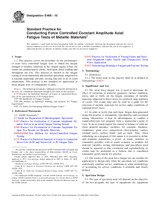We need your consent to use the individual data so that you can see information about your interests, among other things. Click "OK" to give your consent.
ASTM E466-15
Standard Practice for Conducting Force Controlled Constant Amplitude Axial Fatigue Tests of Metallic Materials
STANDARD published on 1.5.2015
The information about the standard:
Designation standards: ASTM E466-15
Note: WITHDRAWN
Publication date standards: 1.5.2015
SKU: NS-609285
The number of pages: 6
Approximate weight : 18 g (0.04 lbs)
Country: American technical standard
Category: Technical standards ASTM
The category - similar standards:
Annotation of standard text ASTM E466-15 :
Keywords:
ICS Number Code 77.040.10 (Mechanical testing of metals)
Additional information
| Significance and Use | ||||||||||||||
|
4.1 The axial force fatigue test is used to determine the effect of variations in material, geometry, surface condition, stress, and so forth, on the fatigue resistance of metallic materials subjected to direct stress for relatively large numbers of cycles. The results may also be used as a guide for the selection of metallic materials for service under conditions of repeated direct stress. 4.2 In order to verify that such basic fatigue data generated using this practice is comparable, reproducible, and correlated among laboratories, it may be advantageous to conduct a round-robin-type test program from a statistician's point of view. To do so would require the control or balance of what are often deemed nuisance variables; for example, hardness, cleanliness, grain size, composition, directionality, surface residual stress, surface finish, and so forth. Thus, when embarking on a program of this nature it is essential to define and maintain consistency a priori, as many variables as reasonably possible, with as much economy as prudent. All material variables, testing information, and procedures used should be reported so that correlation and reproducibility of results may be attempted in a fashion that is considered reasonably good current test practice. 4.3 The results of the axial force fatigue test are suitable for application to design only when the specimen test conditions realistically simulate service conditions or some methodology of accounting for service conditions is available and clearly defined. |
||||||||||||||
| 1. Scope | ||||||||||||||
|
1.1 This practice covers the procedure for the performance of axial force controlled fatigue tests to obtain the fatigue strength of metallic materials in the fatigue regime where the strains are predominately elastic, both upon initial loading and throughout the test. This practice is limited to the fatigue testing of axial unnotched and notched specimens subjected to a constant amplitude, periodic forcing function in air at room temperature. This practice is not intended for application in axial fatigue tests of components or parts. Note 1: The following documents, although not directly
referenced in the text, are considered important enough to be
listed in this practice: E739 Practice for Statistical Analysis of Linear or Linearized Stress-Life (S-N) and Strain-Life (ε-N) Fatigue Data STP 566 Handbook of Fatigue Testing
|
|
Standard Practice for Verification of Constant Amplitude Dynamic Forces in an Axial Fatigue Testing System
|
|
Standard Guide for Statistical Analysis of Linear or Linearized Stress-Life (S-N) and Strain-Life (?-N) Fatigue Data (Withdrawn 2024)
|
|
Standard Guide for Preparation of Metallographic Specimens
|
|
Standard Test Method for Strain-Controlled Fatigue Testing
|
|
Standard Practice for Verification of Testing Frame and Specimen Alignment Under Tensile and Compressive Axial Force Application
|
|
Standard Practice for Presentation of Constant Amplitude Fatigue Test Results for Metallic Materials
|
|
Standard Terminology Relating to Fatigue and Fracture Testing |
We recommend:
Technical standards updating
Do you want to make sure you use only the valid technical standards?
We can offer you a solution which will provide you a monthly overview concerning the updating of standards which you use.
Would you like to know more? Look at this page.




 Cookies
Cookies
